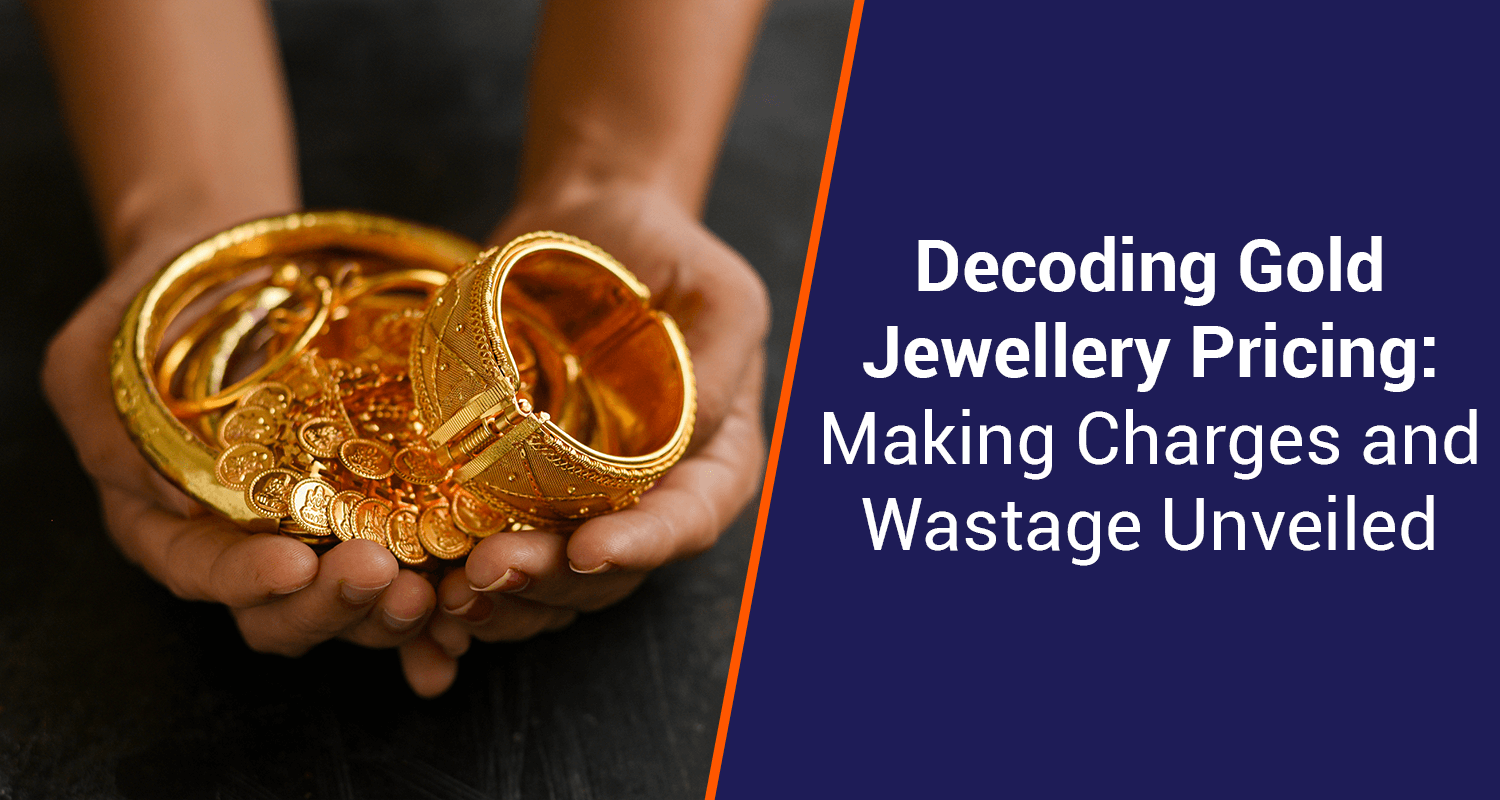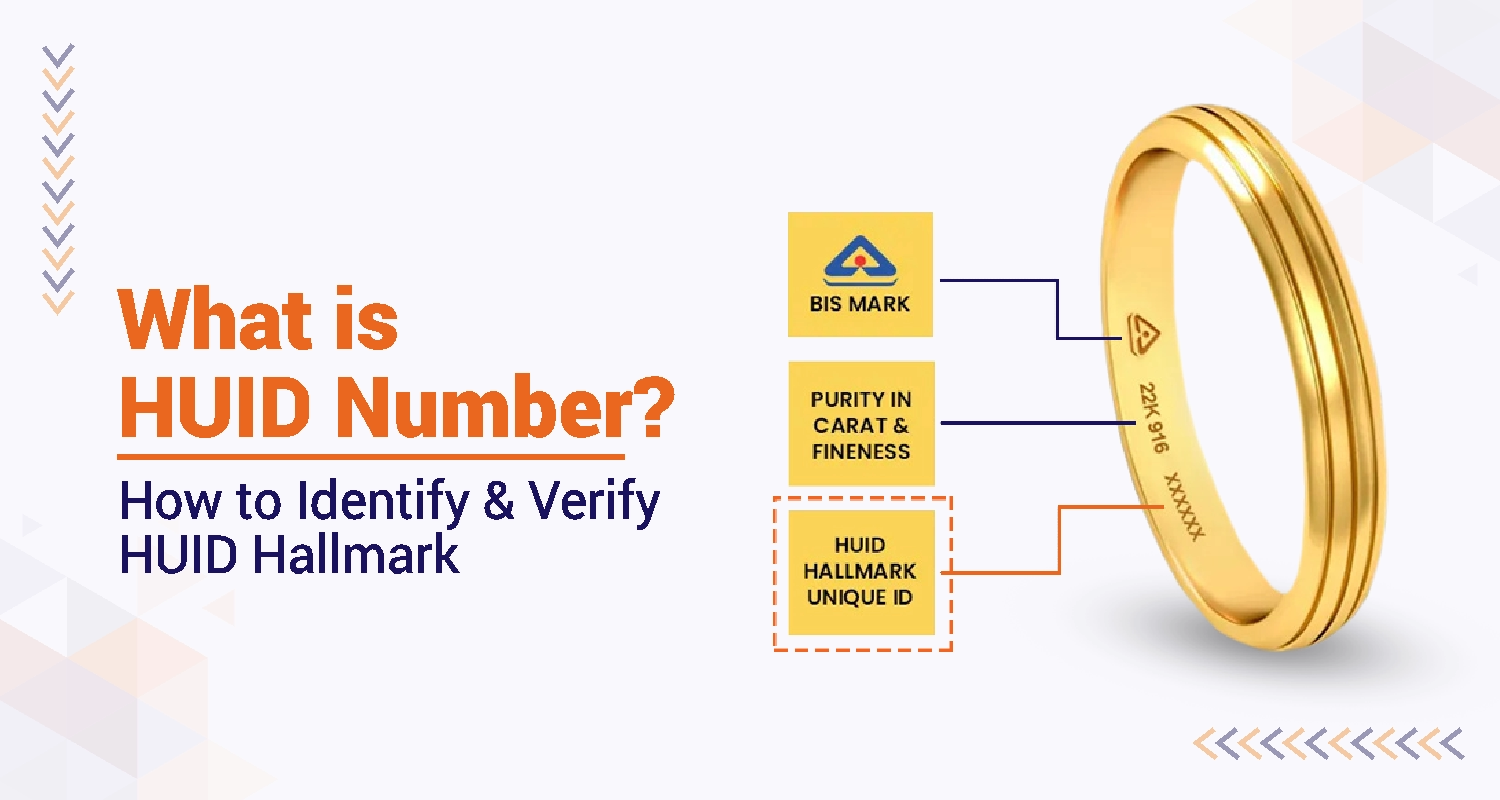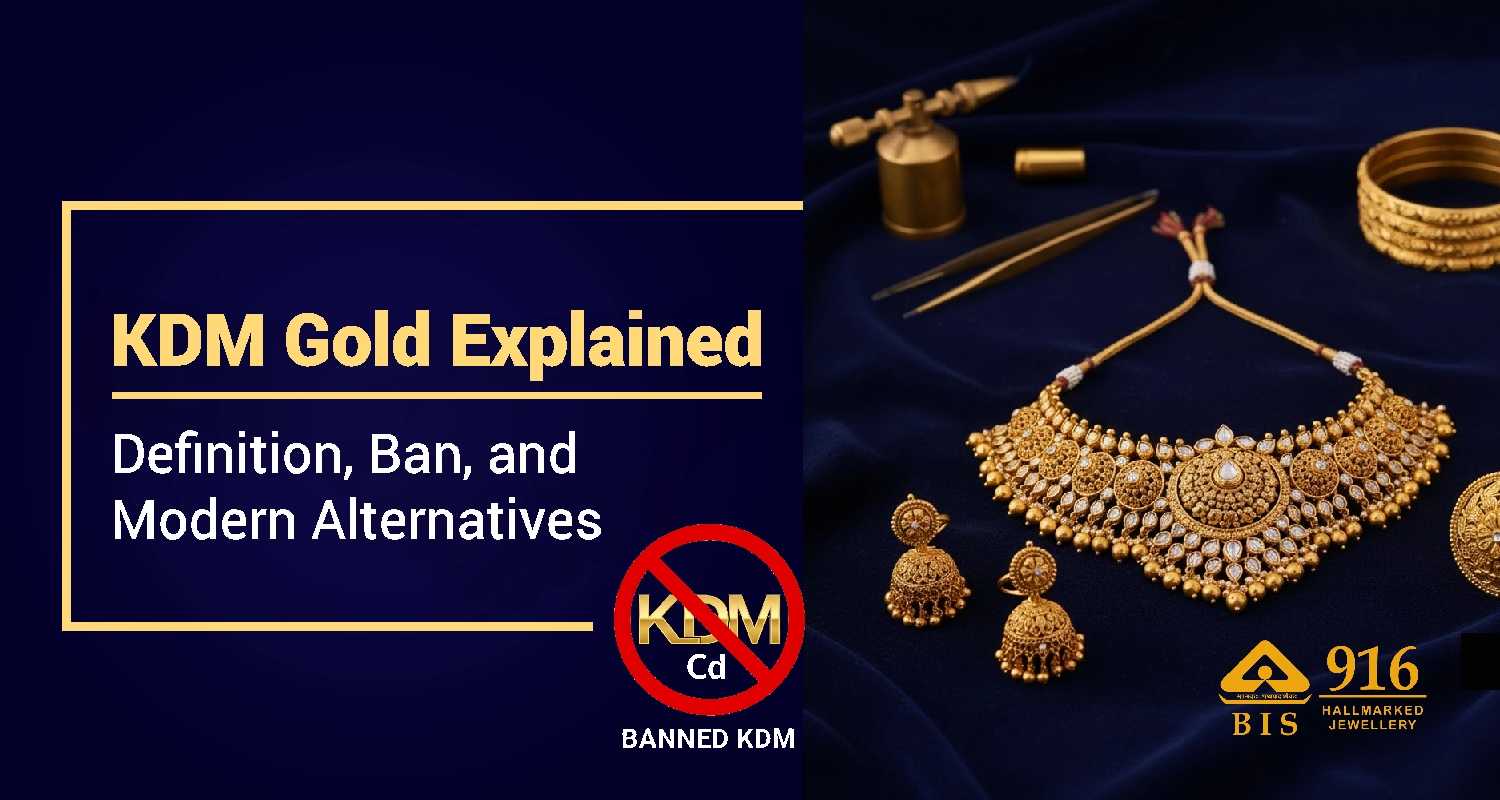Understanding Gold Making Charges and Wastage Percentage

Gold jewellery has always held deep cultural and emotional significance, especially in India, where it is not considered just another ornament, but a symbol of tradition, prosperity, and celebration. Regardless of the occasion, be it a wedding, a festival, or an investment, buying gold is one ritual that almost every family cherishes. So, to make a well-informed value-for-money purchase, it becomes absolutely crucial to understand gold-making charges and wastage charges. These often-overlooked components can significantly impact the final price you pay. Let’s break down what these charges mean, how they’re calculated, and how you can shop smarter when buying gold jewellery.
What Are Gold Making Charges and Why Do They Vary?
Gold making charges refer to the charges applied while converting raw gold into finished jewellery. These charges cover the overhead costs such as labour, time, skill, and other resources involved in crafting a gold ornament. The gold making charges can vary significantly depending upon the intricacy of the design, the quality of craftsmanship, and the reputation of the jeweller. Some pieces may involve advanced techniques or handcrafted detailing, which can further increase the total cost. These charges are usually calculated either as a fixed percentage of the gold’s price or as a flat rate per gram. By comparing gold making charges across different jewellers, buyers can better understand the value they’re getting and ensure they’re not overpaying for workmanship.
Typical Making Charges in India (22K / 24K)
- In many Indian jewellery shops, making charges generally lie in the range of about 3% to 25% of the gold value.
- For well-known brands or more intricate designs, making fees often fall in the band of 8% to 25% of the gold’s value.
- Some premium / designer pieces with heavy handiwork may carry making charges as high as 30% or more in rare cases.
- For simple or mass-produced items, lower ends of the scale (around 3–8%) are common.
How Jewellers Calculate Making Charges
Jewellers use a formula to calculate the final price of gold jewellery, comprising the gold price per gram, weight of gold, making charges, and 3% GST.
Example:
If a 10-gram ornament is valued at Rs. 60,000 per gram, jewellers utilize a formula encompassing gold price per gram, gold weight, making charges, and 3% GST to calculate the final price. For instance, applying the formula to a 10-gram piece priced at Rs. 60,000 per gram:
- Under the Flat Rate Method: A making charge of Rs. 3,000 per gram results in a total making charge of Rs. 30,000.
- Using the Percentage Basis: A 12% making charge on the total gold cost (Rs. 600,000) leads to a making charge of Rs. 72,000. This example illustrates the impact of different gold prices on making charge calculations.
The formula:
Final Price = (Gold Price per gram × Weight) + Making Charges + 3% GST on [(Gold Price × Weight) + Making Charges]
How Do Making Charges Differ?
Making charges imposed by jewellers can vary among different ornaments, influenced by factors such as the type, quality, purity, and source of gold utilized in their production. The unique and creative processes involved in crafting each jewellery piece contribute to this variability. These making charges typically encompass transport costs, import duty, taxes, and handling costs. Additionally, jewellers determine making charges based on the intricacy of the design and the purity of the gold used. More intricate designs, requiring additional time and incurring more wastage, tend to result in higher making charges. Jewellers may opt for a flat rate per gram or a percentage of the total cost, leading to variations in the calculated making charges.
What Is Gold Wastage Percentage?
Gold wastage percentage refers to the amount of gold that is lost during the process of crafting jewellery. This loss can occur while cutting, melting, soldering, or polishing the metal, when small particles of gold turn into dust or residue that cannot be recovered.
The wastage percentage gives an estimate of how much extra gold is used during production to achieve the final weight of your jewellery. It helps jewellers account for the material lost in the making process.
Typical Gold Wastage Percentages:
- 916 (22K) Gold: Usually ranges between 3% to 7%, depending on design complexity.
- 18K Gold: Wastage can be slightly higher, typically 6% to 12%, as the alloy mix and finer detailing lead to more material loss.
- 24K Gold: Pure gold is rarely used for jewellery because it is too soft, but when crafted, the wastage percentage may be 2% to 5%, since designs are simpler and sturdier.
Example:
If you’re buying a 22K (916) gold necklace weighing 20 grams and the jeweller mentions a 5% wastage, the additional gold used would be:
20 × (5/100) = 1 gram.
So, the total gold used in making your necklace is 21 grams, even though the final piece weighs 20 grams.
In short, the wastage percentage reflects the craftsmanship and intricacy of the jewellery and it is usually higher for intricate handmade designs, and lower for machine-made or plain pieces.
Gold Making Charges vs. Gold Wastage Percentage
| Aspect | Gold Making Charges | Gold Wastage Percentage |
|---|---|---|
| Definition | Cost incurred for acquiring craftsmanship such as materials, labour, design complexity, handling, and overheads. | Cost to compensate for the gold lost during melting, cutting, shaping, including dust and scraps. |
| Calculation Method | Charged either as a fixed amount per gram or as a percentage of the total gold cost. | Calculated as a percentage of the total weight of gold used in the jewellery piece. |
| Typical Range | Ranges from flat fee to 3–25% of gold cost. | Ranges between approximately 2% and 10% of the gold weight, depending on the design's complexity. |
| Buyer Insight | Enables buyers to compare the value for craftsmanship and negotiate better. | Helps buyers understand and potentially minimize hidden costs by selecting simpler designs or questioning the wastage policy. |
Factors Influencing Gold Wastage Percentage
Gold wastage percentage isn’t the same for every piece of jewellery — it varies depending on several factors that affect how much gold is lost during the making process. Here are some key influences:
- Design Complexity
Intricate designs with detailed patterns, filigree work, or stone settings naturally lead to higher wastage. The more delicate the design, the greater the amount of gold that gets trimmed, melted, or polished away during crafting. - Craftsmanship
Handcrafted jewellery often has a higher wastage percentage than machine-made pieces. Skilled artisans may lose small quantities of gold while shaping, joining, or finishing each section. On the other hand, mass-produced or cast designs usually involve less loss. - Purity of Gold (916, 18K, 22K)
The purity level directly impacts wastage. For instance, 916 (22K) and 18K gold alloys are relatively harder, leading to slightly more wastage during intricate work. In contrast, 24K gold, being softer, is easier to mold into simple designs with minimal loss. - Seasonal Variations
During festive or wedding seasons, higher demand for elaborate jewellery can push up average wastage percentages due to complex custom designs.
5. Brand Reputation
Reputed jewellers usually maintain transparency and standardize wastage percentages, ensuring fair pricing and customer trust.
How Gold Making Charges and Wastage Percentage Impact Jewellery Pricing
When you are buying gold jewellery, the final price that the jeweller hands over to you is much more than just the daily gold rate. It takes into consideration multiple factors, such as making charge, and GST, each significantly affecting the final cost. Here's a simple breakdown to help you understand the calculation:
Base Price = Gold Weight × Gold Rate per Gram
Making Charges = Either a fixed amount per gram or a % of Base Price
Subtotal = Base Price + Making Charges
GST = 3% of Subtotal
Final Price = Subtotal + GST
Let’s say you’re buying a 10g gold necklace with the following conditions:
- Gold Rate = ₹8,000 per gram
- Making Charges* = 10% of base price
- GST = 3%
| Calculation | Amount | |
|---|---|---|
| Base Price | Rs. 8,000 x 10 gm | Rs. 80,000 |
| Making Charges* (10%) | 10% of Rs. 80,000 | Rs. 8,000 |
| Sub total | Rs. 80,000+Rs. 8,000 | Rs.88,000 |
| GST (3%) | 3% of Rs. 88,000 | Rs. 2,640 |
| Final Price | Rs. 88,000 + Rs. 2,640 | Rs. 90,640 |
Factors Affecting Gold Making Charges
Complexity and Design of Jewellery - The more complex, intricate and detailed the design of the old jewellery, the higher the making and wastage charges. Delicate artistic work, stone settings, or handcrafted motifs require more time, effort, and precision, thereby increasing the labour costs and more gold loss during crafting. On the other hand, simple, plain designs usually attract lower charges.
Manual vs. Machine-Made Jewellery - Handcrafted jewellery usually comes with higher making charges because of the highly qualified skillset required and time involved in manual production. On the other hand, machine-made pieces, which are mass-produced and uniform typically have lower making charges and minimal wastage, making them more cost-effective.
Jeweller Brand and Reputation - Established and premium jewellery brands often charge higher making fees for their craftsmanship, quality assurance, and brand value. While smaller or local jewellers may offer competitive rates, branded stores often justify their charges through certifications, warranties, and standardised practices.
Seasonal or Promotional Offers - During festive seasons, wedding sales, or anniversary offers, many jewellers provide discounts on making charges, or even waive them entirely to attract buyers. Being aware of these promotional periods can help you save significantly on your purchase.
Current Market Trends - Trends in gold prices and consumer demand also influence making and wastage charges. For instance, when demand surges, like during the wedding season or Akshaya Tritiya, Dusshera or Dhanteras, charges are slightly elevated. Similarly, trending jewellery styles that are complex or newly introduced might attract higher charges due to novelty and demand.
Conclusion
Understanding both wastage and making charges on gold is essential when buying gold jewellery, whether online or offline. This knowledge empowers you to make savvy decisions, ensuring you get the best value and quality for your gold investment. Remember, you're not just buying gold; you're supporting the creativity of the designer and the dedication of artisans who turn raw gold into exquisite pieces.
Frequently Asked Questions
There are two main ways to check gold jewellery making charges:
Ask the jeweller directly: This is the most straightforward way. They can tell you the percentage or fixed rate they charge per gram.
Look for it on the price tag: Reputable jewellers often display the making charges alongside the gold price per gram.
Wastage and making charges for gold vary, but here's a general idea:
Wastage: Typically ranges from 2% to 10% of the gold weight.
Making charges: Can be a flat fee per gram (often for simpler designs) or a percentage of the total gold weight (usually for intricate designs). This can range from 3% to 25%.
Eliminating wastage entirely is difficult, but here are strategies to minimize it:
Choose simpler designs: Less intricate pieces require less gold loss during crafting.
Buy gold coins or bars: These have minimal wastage compared to jewellery.
Explore jewellers with low wastage policies: Some offer lower wastage charges or negotiable rates.
Consider gold investment schemes: Some plans allow accumulating gold weight with minimal wastage charges.
There are no fixed gold jewelry or handcrafted jewelry making charges for 22K gold. It depends on the jeweller's skill, design complexity, and overhead costs. It can range from a flat fee per gram (simple designs) to a percentage (3% to 25%) of the gold weight. Always ask the jeweller or check the price tag for their specific rate.
Yes, buyers can often negotiate making charges, especially at local or independent jewellery stores. While branded jewellers may have fixed rates, they sometimes offer seasonal discounts or promotional offers. It's always worth asking—especially when purchasing heavier or high-value pieces.
No, not always. Many jewellers do not mention the charges of wastage percentage on the bill. Instead, it may be factored into the gold weight or adjusted within the making charges. It’s always a wise idea to request the jeweller to disclose the wastage percentage before finalizing your purchase.
No, making charges differ from jeweller to jeweller. Each brand sets its own rates based on factors like craftsmanship, design complexity, brand value, and production method. While some charge a flat rate per gram, others use a percentage of the gold price, usually ranging from 3% to 25% or more.
Yes, GST is calculated on the total cost, which includes the gold price, making charges, and any applicable wastage charges. The GST rate is 3% on the entire taxable value of the jewellery purchase.
In India, gold wastage typically ranges from 2% to 12%, depending on purity and design complexity. Simple designs have lower wastage, while intricate handcrafted jewellery can lead to higher losses during shaping, polishing, and finishing.
Machine-made jewellery usually has lower making charges (around 3–8%) due to precision and efficiency. Handcrafted pieces involve skilled labour and intricate detailing, leading to higher charges (8–25%) to cover the additional time and craftsmanship.
Higher purity gold like 24K is softer and easier to shape, often resulting in lower making charges, while 22K or 18K gold alloys are harder, especially for detailed designs, which can increase labour costs and overall making fees.
Some jewellers offer promotional discounts or waive making charges during festive seasons or for bulk purchases. However, discounts depend on the store, design complexity, and ongoing offers, so it’s best to confirm with the jeweller before buying.
GST is charged 18% on making charges (labour or craftsmanship portion) and 3% on the gold metal value if sold by weight. It’s calculated separately from the gold price to ensure transparency in the total cost.
For gold loans, lenders consider only the pure gold content. Making and wastage charges are not included in the valuation, so they don’t affect the eligible loan amount, which is based solely on weight, purity, and current gold rates.
When you apply for a gold loan, lenders consider only the pure gold value, not the making charges or wastage. These additional costs are excluded from the gold’s valuation. You can use the Gold Loan Calculator to check your eligible loan amount based on the net gold value.
Disclaimer : The information in this blog is for general purposes only and may change without notice. It does not constitute legal, tax, or financial advice. Readers should seek professional guidance and make decisions at their own discretion. IIFL Finance is not liable for any reliance on this content. Read more



